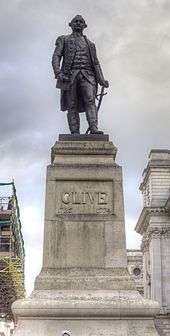Statue of Robert Clive, London
A Grade II-listed bronze statue of Robert Clive, 1st Baron Clive, by John Tweed, stands in King Charles Street, Whitehall, London.[2] The work was unveiled in 1912 outside Gwydyr House, also in Whitehall, and was moved to its current location in 1916.[3][2][1]
| Statue of Robert Clive | |
|---|---|
 The statue in 2010 | |

| |
| Artist | John Tweed |
| Year | 1912 |
| Medium | Bronze |
| Subject | Robert Clive, 1st Baron Clive |
| Location | King Charles Street, London SW1 |
Listed Building – Grade II | |
| Official name | Statue of Clive on steps at west end |
| Designated | 14 January 1970 |
| Reference no. | 1221431[1] |
Description
On the west face of the plinth are Clive's surname and the year of his birth and death (1725–1774).[4] The remaining three sides have bronze reliefs depicting events in his life: the Siege of Arcot in 1751, the eve of the Battle of Plassey in 1757 and the Treaty of Allahabad in 1765.[4]
History
On 8 February 1907, Sir William Forwood wrote to The Times noting that there were no monuments to Clive in London or India, and that even his grave, in the church at Moreton Say, Shropshire, was unmarked.[5] Lord Curzon, a Conservative politician and the former Viceroy of India, wrote in support of Forwood's complaint, though he noted that in 1860 Clive had been "tardily commemorated by a statue at Shrewsbury".[6] A Clive Memorial Fund committee was established, with Curzon publicising the fundraising efforts and progress with further letters to the editor of the Times.[7] An 18th-century statue of Clive by Peter Scheemakers inside the India Office was then brought to Curzon's attention, but Curzon considered both its portrayal of Clive and the location to be inadequate.[8] The fund raised between £5,000 and £6,000 to erect memorials to Clive in London and India.[5] Curzon's proposal did not meet the favour of his successor as Viceroy, Lord Minto, who considered it "needlessly provocative".[9]
John Tweed was commissioned to start work on the London statue and exhibited a sketch model at the Royal Academy in 1910.[10] A smaller version of the finished statue, also cast in bronze, is now part of the collection of the Tate in London.[10] Other depictions of Clive by Tweed include a memorial tablet, erected by public subscription, in 1919, in the south choir aisle of Westminster Abbey[11] and a marble statue at the Victoria Memorial in Kolkata, India.[12]
21st century
At the beginning of the 21st century, the statue was singled out for criticism by Nick Robins in his history of the East India Company, The Corporation that Changed the World. In the book, he argued that "the fact that one of Britain's greatest corporate rogues continues to have pride of place at the heart of government suggests that the British elite has not yet confronted its corporate and imperial past." The book concluded by calling for the statue to be removed to a museum.[13]
In June 2020, calls were made for the statue's removal after a wave of anti-racism protests in which a statue of the slave trader Edward Colston in Bristol was pulled down. The Labour politician Lord Adonis asked the Government to begin a public consultation on the statue.[14] Clive's statue will be considered in a review of London's public monuments ordered by Sadiq Khan, the Mayor of London.[15] With Andrew Simms, Nick Robins repeated his call for the statue to be removed and replaced with a monument celebrating a new generation of diverse global heroes.[16] The historian William Dalrymple compared the statue's 20th-century memorialisation of Clive to the Confederate monuments erected in the Southern United States well into the civil rights era.[9] The writer Afua Hirsch similarly said that the statue was "not a piece of history but an attempt – when it was erected centuries after Clive's death – to rewrite it" and called Clive "a symbol of the most morally bankrupt excesses of Empire".[14]
See also
- Bali Bombings Memorial, London, located nearby
References
- Historic England. "Statue of Clive on steps at west end (1221431)". National Heritage List for England. Retrieved 26 September 2014.
- "Statue: Lord Clive". London Remembers. Retrieved 2014-09-26.
- "Statue of Lord Clive". Discovery. The National Archives (United Kingdom). Retrieved 2014-09-26.
- "Robert Clive – London, UK – Statues of Historic Figures". Waymarking. Retrieved 2014-09-26.
- "The campaign to remember Clive of India". Shropshire Star. 2011-05-27. Retrieved 2014-09-26.
- Ward-Jackson 2011, p. 109.
- 'Curzon.' (1907-08-13). "Clive Memorial Fund". The Times. The Times Digital Archive.
- Ward-Jackson 2011, pp. 109–110.
- Dalrymple, William (11 June 2020), "Robert Clive was a vicious asset-stripper. His statue has no place on Whitehall", The Guardian, retrieved 11 June 2020
- "John Tweed Lord Clive c.1910–12". Tate. Retrieved 2014-09-26.
- "Robert Clive". Westminster Abbey. Dean and Chapter of Westminster. Retrieved 2014-09-26.
- "Sculptures and Statues". Victoria Memorial (India). Retrieved 2014-09-26.
- Robins, Nick. (2012). The corporation that changed the world: how the East India Company shaped the modern multinational (2nd ed.). London: Pluto Press. ISBN 978-1-84964-691-8. OCLC 820849779.
- "The Londoner: Now Clive of India is a monumental problem", Evening Standard, 9 June 2020, retrieved 11 June 2020
- Bland, Archie (10 June 2020), "After Colston, figures such as Drake and Peel could be next", The Guardian, retrieved 11 June 2020
- Andrew Simms (2020-06-10). "Reckoning with Britain's imperial legacy: time to search for new heroes". New Weather Institute. Retrieved 2020-06-20.
External links
